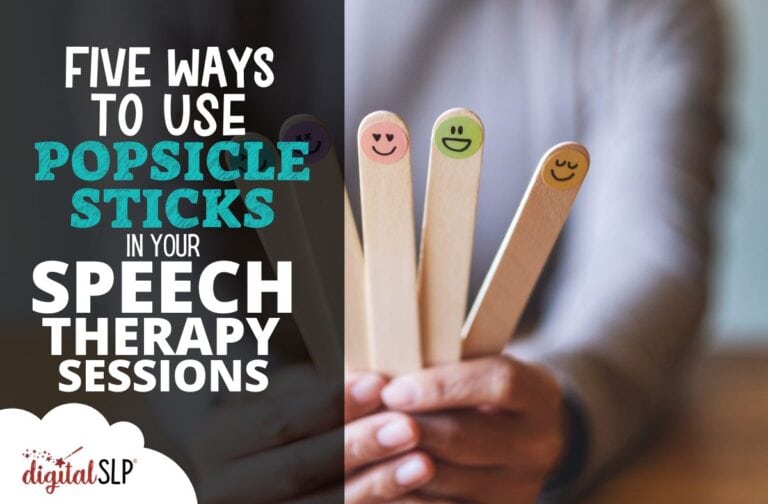In this blog, I am going to be talking about how to use themes in speech therapy, how to implement thematic instruction based on research, and why thematic approaches support language skills.
When it comes to planning your therapy sessions, how do you go about the process? Do you pick out one activity and adapt that activity for all of the students you see that day? Do you incorporate drill work to target your students’ goals followed by reinforcements? Do you create theme calendars to base your lesson plans off of each week?
There are so many different ways to go about planning therapy sessions, but today I will focus on incorporating themes in speech therapy sessions to support language development. Many speech therapists use themes within their sessions, creating a fun and engaging session for the students. What many speech therapists forget or may not know about when planning theme-based therapy sessions is the evidence-based research around how themed therapy should be implemented and how thematic instruction supports language development.
What is a Thematic Approach to Speech Therapy?
A thematic approach can be defined as “the creation of various meaningful activities planned around a central topic or idea. The activities are then integrated into all aspects of the curriculum” (Del Duca, Maria, 2013). When thinking about using thematic approach in speech therapy, you’ll need to select a theme and then highlight this theme through various activities/lessons. This theme can be carried throughout an entire therapy session or even multiple therapy sessions. You may even select a theme that the client’s classroom is also discussing in order to help your client experience the same theme/curriculum across several domains of learning.
Now that we understand what a thematic approach may look like within our therapy sessions, let’s consider what a thematic approach may NOT look like in sessions. Have you ever grabbed materials with adorable clipart that correlates to a certain theme, but the actual content within the material does not match that theme? This would not be a thematic approach.
One key factor to remember when using a thematic approach in therapy would be to select materials where the content, graphics, activities, concepts, etc. all incorporate the same theme. For example, grabbing WH-question cards that have ADORABLE bug clipart on the back of each card does not constitute a theme. Instead, to incorporate a themes in speech therapy, select a book about springtime to incorporate spring vocabulary, learn all about life cycles such as those of tadpoles changing into frogs or caterpillars turning into butterflies, retell stories or sequence the steps of animal life cycles, create springtime sensory activities such as planting flowers, complete springtime crafts to go along with books or activities, or even use interactive items during pretend play such as puppets while using all of the information your students have learned throughout therapy sessions about springtime!
Incorporating a thematic approach will help your students fully dive into a theme, improving vocabulary and building more connections between different concepts.
How Using Themes in Speech Therapy Support Improved Language Skills?
According to Maria Del Duca, “Thematic instruction helps to teach our children about categories… our students are improving their semantic mapping/networking skills thus improving receptive and expressive vocabulary, understanding and using synonyms and antonyms, word retrieval skills, story comprehension and story retelling skills, answering WH-questions, as well as improving their ability to make inferences and predictions, thus resulting in improvements in overall language skills” (Del Duca, Maria, 2013). Research conducted on the use of thematic instruction with students has demonstrated benefits in building connections between concepts as well as building semantic networks.
When you’re planning sessions using a thematic approach, there are many different concepts that may be targeted; using this approach helps to link these various concepts together, building upon the student’s vocabulary and understanding of semantic relations. For example, when talking about the beach, your students may be learning all about the different animals who live in the ocean; this may turn into learning the difference between animals who live in the ocean versus the farm versus the zoo. Now you are moving into new themes that all categorically go together. Your students will be able to make connections between these various language concepts and themes instead of just learning about one isolated concept. According to Hadley et. al, “The knowledge of one concept supports the learning of another.” Hadley also explained that “concepts may be linked, so the learning of one can help leverage the learning of another” (Hadley et al., 2018). Using thematic approaches within speech therapy sessions may also provide a more meaningful method to use when learning new concepts, helping students engage with the content being taught.
Top three tips to consider when planning a thematic approach within your therapy sessions:
- Consider your student’s interests: when selecting a theme to use within sessions, think about what your students are interested in learning and build from there. If you select themes that interest your students, they will be more motivated by and engaged with the lessons you plan.
- Select themes that correlate with the curriculum: look at what is being taught within the classrooms and build upon those concepts. If you are able to select themes that are being taught currently in the classroom or were discussed previously in the classroom, then you are building upon the student’s previous knowledge.
- Use various methods of incorporating themes: incorporate a variety of different activities using multiple senses when planning thematic-based sessions. For example, when planning a therapy session around a beach theme, you may read books about the beach or sea animals, create a water and/or sand sensory bin, watch videos, create movement-based activities to go along with the theme, etc.
When planning your next session, think about how you would incorporate themes in these speech therapy sessions in order to continue to support your students’ language development.
RESOURCES:
- Del Duca, Maria. “Kid Confidential: Using Thematic Instruction in Speech Therapy.” Leader Live (2013).
- Hadley, Elizabeth B., et al. “Building semantic networks: The impact of a vocabulary intervention on preschoolers’ depth of word knowledge.” Reading Research Quarterly 54.1 (2019): 41-61.
- The Digital SLP Membership













Recent Comments